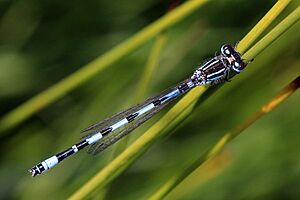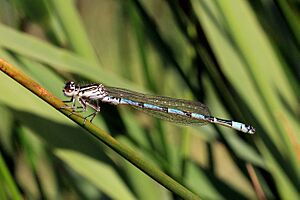Southern damselfly facts for kids
Quick facts for kids Southern damselfly |
|
|---|---|
 |
|
| Male, Parsonage Moor, Oxfordshire | |
 |
|
| Female, Dry Sandford Pit, Oxfordshire | |
| Conservation status | |
| Scientific classification |

The Southern Damselfly (scientific name: Coenagrion mercuriale) is a small, colorful insect. It belongs to the damselfly family, which is related to dragonflies. You can find these damselflies in many countries. They live across Europe and North Africa. This includes places like France, Germany, Spain, and the United Kingdom. They also live in countries like Algeria and Morocco.
These damselflies love to live near water. Their favorite places are rivers and freshwater springs. Sadly, their homes are disappearing. This means the Southern Damselfly is a threatened species.
The second part of their scientific name, mercuriale, is quite special. It comes from a unique mark on their body. This mark is on the second part of their abdomen (their belly). It looks like the symbol for the planet Mercury (☿). Because of this, some people also call them the mercury bluet.
Where They Live
Southern Damselflies need specific places to live and lay their eggs. They like areas with open plants and slow-moving water. This mix helps them survive and have their young.
Life Cycle
The young damselflies are called larvae. They spend about two years living underwater. They grow and develop there. After this time, they come out of the water. Then, they change into the adult damselflies we see flying around.
Protecting Them in the UK
A large part of the world's Southern Damselfly population lives in the United Kingdom. About 25% of all Southern Damselflies are found there. However, their numbers have dropped a lot. Since 1960, their population has gone down by 30%.
This decline is due to several reasons. Changes in how land is used for grazing animals have affected them. Also, land being drained and water being taken from their habitats causes problems.
People are working hard to help these damselflies. In 2015, efforts began in places like the New Forest in Hampshire and the Preseli Hills in Pembrokeshire. These projects aimed to make their homes better. By 2020, these efforts were reported as successful.
Another example is in Devon. In 2009, about 500 adult damselflies were moved to the Venn Ottery nature reserve. This reserve is looked after by the Devon Wildlife Trust. They brought back grazing animals to the area. This helped the damselflies, who had not been seen there since 1988.
The Southern Damselfly is a protected species in the UK. It is listed under a law called Schedule 5 of the Wildlife and Countryside Act 1981. This law helps keep them safe.
Images for kids




